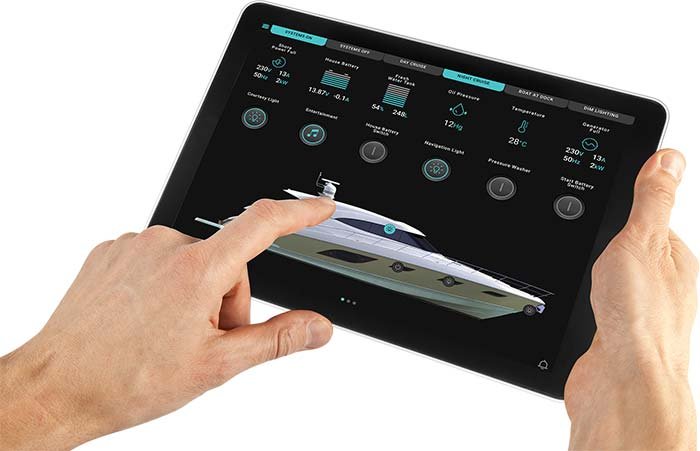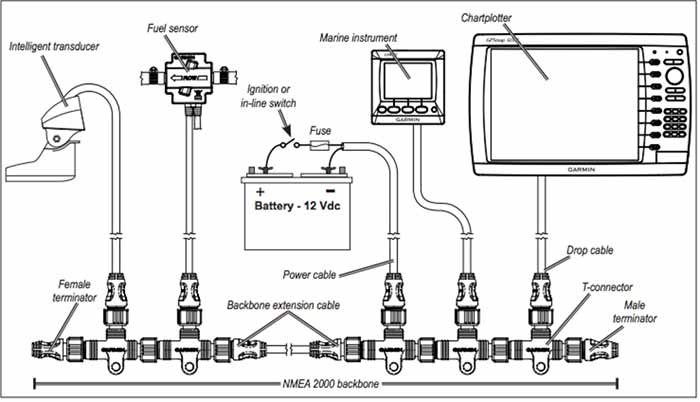Advertisement
Digital data has revolutionized our world, and boatbuilders are adapting the new technologies.

Systems like CZone allow users to control onboard systems at the touch of a button.
The irony of boats today — just as with automobiles and, well, almost everything around us — is that as their systems become considerably more complex, they themselves are becoming much easier to operate. There are all sorts of ways you can interact with your boat, whether you're on board, sitting at home, or on the other side of the planet. With all sorts of gee-whiz technology and smartphone apps, it's now possible to keep an eye on your baby from virtually anywhere.
Tip
Remote Monitoring
Most owners feel a slight sense of relief every time we walk down the dock and see our boats securely tied up and floating in their slips. That's because boats spend a lot of time unattended. We put them away at the end of the weekend and, after checking the docklines one last time, head home, leaving the boat to mostly fend for itself. We may wonder (especially in foul weather) if our boats are OK when we're not there. What if the bilge is filling with water? Did I leave a light on? Has the fridge stopped working? Has someone stolen my boat or the electronics aboard?
Several manufacturers are offering connected solutions, and the number is growing. Products such as GOST, Insight, Siren Marine, and Nautic-On now offer a variety of features that utilize connectivity. While there are differences between manufacturers' purposes, the basic principles of operation are similar: Embedded sensors are connected on a boat to communicate over a network governed by a central unit. The sensors are either hardwired or connected via Bluetooth to monitor systems (e.g., bilge pumps, high-water alarms, state of battery charge, and interior temperature) and/or provide remote switching capabilities. The collected data is relayed via a cellular or Wi-Fi communicator to a cloud-based service, which in turn uses Wi-Fi or cellular service to communicate with a smart device.
Should an alert be triggered by one of the sensors, a text or voice alert is sent to one or more designated numbers allowing a speedy response if required. A connection is not limited to one way either; just about all the systems allow owners to check critical systems via a dedicated app. Some go even further: The Siren Marine app allows control of some onboard systems such as lights, battery switches, air conditioning, and anything else connected to one of their electronic relays.
Advertisement
All the systems mentioned also have what's known as "geofencing." If the boat moves outside a user-designated area, an alarm is sent to your phone, so you know if your boat is being moved without permission — or worse, being stolen. Geofencing is so accurate it can even be used as an anchor-drag alarm when you're on your boat. Nautic-On offers geofencing, remote monitoring of battery, bilge, and engine — and even offers alerts when bad weather may impact your boat, focusing on conditions most important to boaters.
"Connected solutions have come of age in the boating ecosystem," says Lou Sandoval, national director of business development at Nautic-On.
"Nautic-On is designed to let you spend more time on the water and less time worrying about your boat," adds Adam Schanfield, Nautic-On's general manager.
A new player in the boat-monitoring market, named Boatrax, is a small black-box computer installed inside the helm that monitors and logs all vital boat systems, from fuel burn to engine temperature. Boatrax's makers promote the idea of a comprehensive service log of all boat systems as beneficial for both parties in a used boat sale/purchase. Like other monitoring products, Boatrax also allows remote monitoring of location, onboard alerts, and alarms.
Expect to see more and more new boats sold with some remote cloud-based vessel monitoring and control.
What is NMEA2000?
Start talking electronics and a term you'll hear a lot is NMEA, often pronounced neem-uh. NMEA refers to National Marine Electronics Association, an industry body that oversees and coordinates the work of member organizations, electronics manufacturers, and other interested bodies. NMEA2000 is the agreed protocol that allows an almost unlimited number of instruments to "talk" to one another via a special dedicated cable.
NMEA2000 is a voluntary standard to which just about all the major electronics manufacturers subscribe. It allows interconnectivity between pieces of electronic hardware irrespective of the manufacturer. A backbone, or trunk cable, is installed in the boat (see diagram above) into which equipment is connected via drop cables and T connectors. This system allows for new stuff to be installed relatively easily — it's essentially plug and play. A new T connection is inserted into the backbone and the new equipment connected. Once powered up, it is recognized and able to share data across the entire network. So, for instance, if you install and connect a new sonar transducer to the network, the information it transmits will be available on any number of multifunction displays, no matter how many may be installed.
There are five tiny wires inside the backbone and drop cables connecting everything. These wires both power the network and allow for the transferring and sharing of data across interconnected devices. Unlike older analog equipment where data flowed in only one direction, from a talker to a listener (NMEA0183 data), on the NMEA2000 network, data can be shared in both directions and at a much faster rate.
Digital Switching
Technically speaking, digital switching is a digital control and monitoring system that replaces standard analog switch panels and long runs of wiring with lightweight modules, which are electronic control boxes not much larger than a smartphone. Wired analog systems are difficult to install, and especially to troubleshoot, and corrosion is a chronic problem with all those hidden wires running through the boat.
Practically speaking, digital switching allows you to control onboard electrical and electronic systems — lighting, entertainment and security systems, navigation lights, and everything in between — from your multifunction display (MFD), smartphone, or tablet. This may sound complicated, but once you see it in action, it's intuitively easy.
Digital switching has been integrated in motor vehicles for more than a decade, then in large yachts, and is now migrating to smaller boats from brands like CZone, SeaStar Solutions, and Raymarine.
"People want their boats to operate like cars. With CZone they can push a button on a remote as they walk down the dock, and it will turn everything on for them. The boat's ready to go almost as soon as they step aboard," explains Steve Potts, CEO of Scout Boats, an early and enthusiastic adopter of the system. Scout Boats come standard with the integrated CZone system.
Yet another cool feature is that digital switching is user-configurable and totally customizable. For instance, touching a virtual switch (or digital "button") on the control will dim all the internal lights while simultaneously turning on the navigation lights for sailing at nighttime. Mix and match to meet your needs. While the primary market for digital switching is custom boatbuilders, some production manufacturers like Scout have embraced the technology, a trend that will likely extend to other boatbuilders in the future. There's no going back from here.
Not Just For Modern Boats

The Actisense EMU-1 converts analog engine data
to NMEA2000.
If you're feeling left out of all this digital talk because you have an older boat, you don't have to be. While converting an analog boat entirely to digital is a job too big for most DIYers, a partial conversion is a good option that offers many of the benefits of digital.
I'm in the process of upgrading Seaglass, my 1988 Grand Banks trawler. The boat is 30 years old but has good bones, and I'm slowly improving the electronics. I've taken out a plethora of mismatched and redundant displays and installed a couple of MFDs, a 12-inch Raymarine unit at the upper helm, and a 16-inch Simrad unit at the lower, all connected into a NMEA2000 network I've installed on the boat.
I'm also ridding the boat of many of the power-hungry halogen lights and replacing these with LEDs. Although I'm not ripping out all the analog switches yet, I am installing a localized C-Zone system for the new lights, something I'll be able to expand in coming years as time and pocketbook allow.
Part of the upgrade for a cleaner look is to get rid of the old analog displays on the helm panel including tachometer, oil pressure, engine-oil temperature, and fuel level and incorporate these so that they can be displayed on the MFD. To do this I'm using the EMU-1 from Actisense — a handy gizmo that converts analog signals into digital signals allowing them to be imported into the NMEA2000 network and thus displayed on any MFD that is connected to the network. The British electronics manufacturer also manufactures other products that will enable older, previously incompatible NMEA1083 transducers to be combined into more modern NMEA2000 systems.

